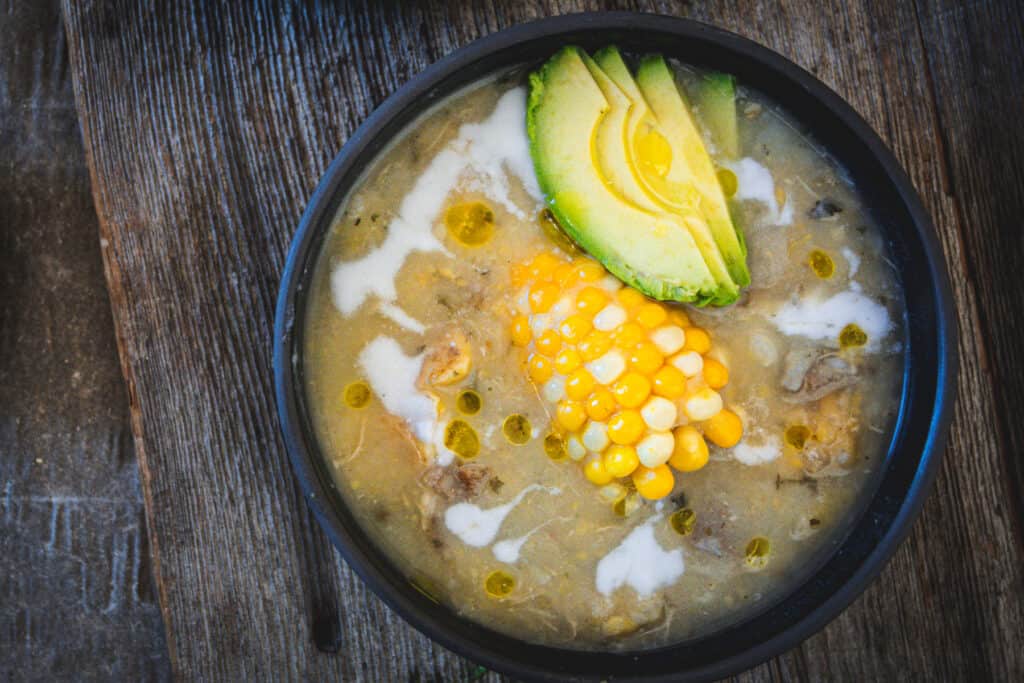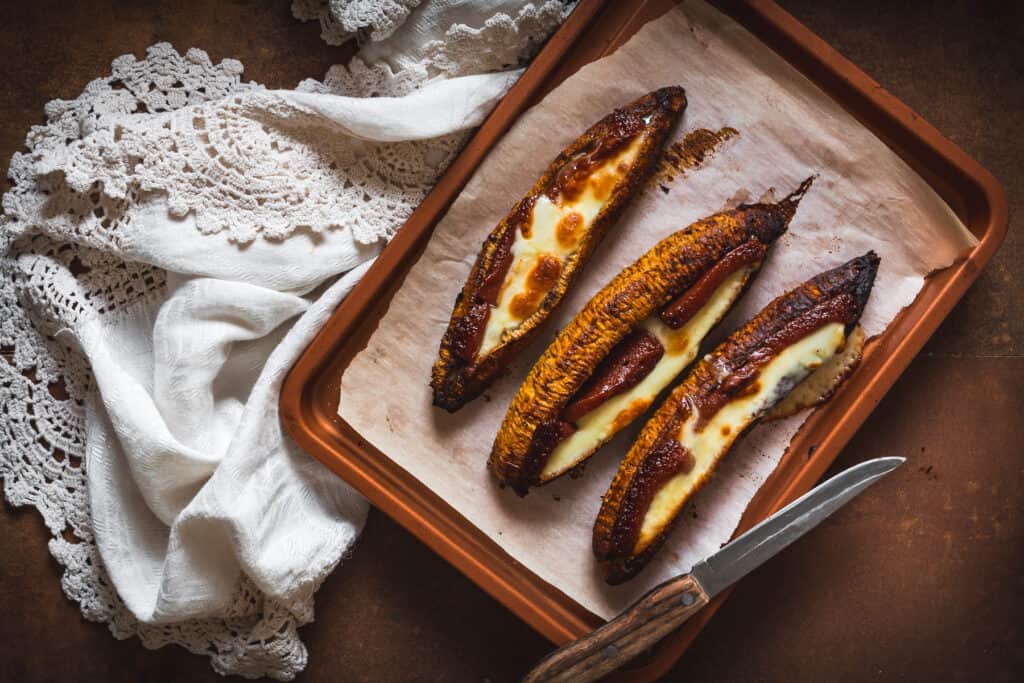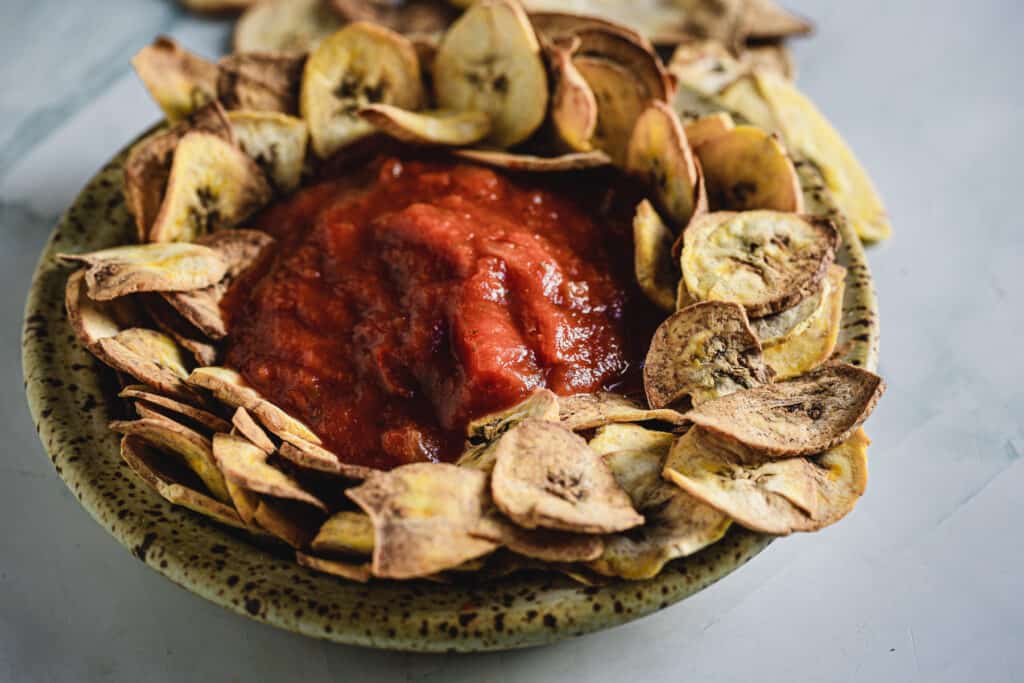Traditional Colombian food is as diverse as the country it represents. From the Caribbean coast to the jungles, the glittering streets of Bogota to the little pueblos, Colombian cuisine is a smorgasbord of tastes and textures. Here’s everything you need to know to discover traditional Colombian cuisine!

What is traditional Colombian food?
Colombian cuisine is a mix of various cultural influences from around the world and the unique flora and fauna that reigns along this unique equatorial region.
Traditional Colombian cuisine has a diverse range of dishes — from soups and stews to meat dishes that are abundant in flavor and spices, and sweet desserts and juices that highlight local exotic fruit. It celebrates the use of unique regional ingredients such as beans, meat, vegetables and tropical fruits, and presents them in very simple and unadorned forms.
The uniqueness of this cuisine, besides the local ingredients, stems from the geography of the country. Along the Caribbean coast of Colombia, food is influenced by African cuisine. In the Amazon jungles, a myriad of local indigenous Colombian communities offer their own culinary microcosms. Along the communities that surround the Andean mountains, Colombian coffee beans, cocoa and “llanero” (cowboy) culture compete for attention. In the areas bordering the Pacific Ocean, seafood and fish of all forms are accentuated by special, locally grown herbs and spices.
In short, it is clear that Colombian cuisine is more than just food; it is part of the country’s cultural heritage.
A bit about Colombian geography
What makes Colombian gastronomy so unique is undoubtedly the country’s geography.
Across the country, there are the Andes Mountains, which run from north to south and are home to several active volcanoes. To the east, there is a vast Amazon rainforest, a barely traversable array of tropical flora and fauna that is hostile at best, and downright life-threatening at worst. Meanwhile, the Caribbean and Pacific coasts offer tropical climates and abundant marine life. The country is also home to numerous rivers, including the Magdalena, which is the country’s largest and most important river for transportation and commerce.
The varied geographical features of Colombia have a significant impact on the country’s cuisine. The Andean range and the jungle at the heart of the country make transporting people and commodities extremely difficult. It also means that the people living in the different parts of the country have, over time, developed their own culture, and their own cuisines, pretty much autonomously.
As a result, the country’s geography influences both the availability of fresh ingredients and the different cooking techniques used throughout the various regions of the country.

What flavors are in Colombian food?
Colombian food offers a mix of indigenous, African and Spanish influences and boasts a wide range of dishes that vary from region to region.
The traditional Colombian kitchen includes ingredients like plantains, yucca, corn, potatoes, meat (particularly beef, pork, and chicken), and a variety of flavorful sauces and spices. Coconut milk is popular along the Caribbean coast, while white rice is abundant throughout the country — and some will say that no Colombian meal is complete without it.
Contrary to popular conception, Colombian cuisine is not known to be spicy. It is, however, flavorful and hearty, making it a delight for food lovers everywhere.
What makes Colombian food unique?
There are several factors that make the food of this country so unique.
Its history of colonization mixed with a rich indigenous culture to produce a unique blend of indigenous, African and Spanish influences.
Second, though Colombian cuisine may vary from region to region, it is always characterized by the use of fresh ingredients, bold flavors, and vibrant colors. Colombians are just as likely to serve a special local fruit completely raw for dessert as they are to use plantains in four different preparations in the same meal, and each of these dishes will taste completely distinctive.
Another unique aspect of food in Colombia is the love and respect for traditional cooking methods. For example, the preparation of sancocho, a hearty soup with chicken, yuca, corn and other vegetables, often involves hours of slow cooking over an open flame. Another traditional Colombian cooking method involves cooking a goat or a pig overnight in a brick kiln.
And finally, Colombian food is undoubtedly famous for its variety of tropical fruits. The most well-known fruit are guava, passion fruit and pineapple. But some of the most interesting Colombian fruit are only discovered upon arrival — like guanabana, lulo and uchuvas, among many others. These fruits are often used in desserts and juices, most commonly mixed either with water or with milk as opposed to each other.
All of these factors contribute to making Colombian food a truly unique and delicious experience.

Popular Colombian dishes to try
As you have probably gathered, there are many popular and traditional dishes to try in Colombia!
- Colombian Empanadas: One of the most popular street foods is Colombian empanadas, which are fried or baked pastry pockets filled with meat, potatoes and sometimes vegetables or cheese empanadas.
- Colombian Arepas: A close cousin of the empanada is the Colombian arepa. This savory fried dough disc is made of corn flour and filled with a variety of tasty ingredients such as shredded chicken, beef, or beans.
- Colombian arepas con queso: Cheese arepas are also quite popular, made by mixing cheese into the dough itself. It’s not uncommon to see kiosks selling arepas on every street corner in Colombia, and they are often served as a quick and filling breakfast or snack.
- Colombian soups: soups are a major food group in Colombia. These are hearty and flavorful, with ingredients like chicken, beef, potatoes and plantains. One type of soup that is especially popular is “sancocho,” a soup often made with coconut milk and is popular in coastal regions of Colombia. Some breakfasts include “changua,” a soup made with milk, scallions and cheese.
- Colombian ajiaco: This is most likely the most popular Colombian soup . It’s a stew that is popular for its mix of chicken, Colombian corn and at least three different types of potatoes, including Colombian papa criolla. Ajiaco gets its special flavor from guascas, an unparalleled local herb, and is considered a comfort food by many.
FDL’S 75 Best Bites

Our cookbook with 75 tasty recipes will be your go-to kitchen companion for easy dinners with ad-free recipes right at your fingertips. Crafted by experienced chefs and recipe developers, this collection offers a treasure trove of tried-and-true dishes that make mealtime a breeze.
Get the Recipe: FDL’S 75 Best Bites
- Bandeja paisa: A famous breakfast dish from the Antioquia region of Colombia. This is a hearty plate composed of beans, rice, plantain, ground beef, chorizo, fried egg and avocado. This dish truly represents the richness of the country’s cuisine incorporating ingredients from different localities.
- Arequipe: This Colombian caramel sauce made from cow’s milk, similar to dulce de leche, is typically Colombian.
- Colombian hot chocolate: This Colombian drink is different from that typically found in other countries because it is made with whole milk and chocolate shavings, which are melted down and mixed together. It is also sweetened with panela, a block of brown sugar that is prepared it by heating newly extracted cane juice in metal containers placed on top of a stove that is powered by the dried remnants of squeezed cane. Most interestingly, Colombian hot chocolate is often served with a small piece of Colombian cheese inside the cup, or alongside small cheese-filled cakes known as “buñuelos.”
- Rellena: This blood sausage filled with rice, peas and blood is first boiled and then fried, and always served with Colombian aji, the only Colombian hot sauce widely spread across the country. It is most often had as part of a “fritanga,” a tray of fried finger foods.
- Ants (“hormigas culonas”): imilar to Mexican food, Colombians don’t shy away from any protein, even those that are considered squeamish in the Western world. “Hormigas culonas” (big ass ants), are a traditional Colombian delicacy that has been consumed for centuries. These large black ants are found in the Amazonian regions of Colombia and are considered a delicacy due to their unique flavor. They are often compared to popcorn due to their crunchy texture. In Colombia, ants are typically fried or roasted with salt and served as a snack or appetizer alongside a cold beer.
- Plantains: Plantain, a savory cousin of the banana, is a staple that is eaten throughout Colombia in a myriad of ways. “Platanos maduros fritos,” or ripe fried plantains, are a popular breakfast food served alongside eggs. Another tasty dish is “Plátanos Asados con Bocadillo y Queso,” which is baked plantains with guava and cheese. This savory dish is perfect as a snack or side dish, and the combination of sweet and salty flavors is a mouthwatering experience. A healthy take on plantain chips can be made in the air fryer! Plantains can also be mashed and used to make “patacones,” or fried green plantains, which are a crispy and delicious snack.

To wrap up
In short, Colombian food culture is diverse and is influenced by its geography. Wherever you go, you will discover that Colombia is one of the tastiest and most culinary unique regions of the world. Colombian cuisine is full of flavorful and delicious Colombian food that satisfies the soul, and that has been prepared with love and heart for generations. So if you are lucky enough to visit Colombia, or at least to have a Colombian restaurant nearby, take care to truly indulge in the traditional Colombian food that the country has to offer, which is sure to leave a lasting impression.
Ksenia Prints is a food writer, blogger, photographer and recipe developer from Montreal, Canada. She blogs over At the Immigrant’s Table, a food blog showcasing healthy, beautiful international recipes for adventurous home cooks. She loves to highlight ethnic cuisines and immigrant cultures by working with chefs from relevant countries, and to adapt those recipes to gluten free, vegan, vegetarian, sugar free and other dietary restrictions.
This article originally appeared on Food Drink Life.